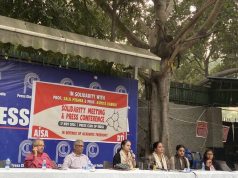Is Delhi the Capital of Child Labour?
To substantiate the grim reality of child labour, a rapid assessment of the Knowledge, Attitude and Practice of 300 employers of child labour in the unorganised sector (notorious for child labour) was done. The findings point to apathy, absence of any form of regulation and illiteracy amongst employers themselves:
- 51% of the sample employs children in 5-14 years, when these children should be in school, While 47% of
respondents were aware of the law, this has not deterred them from employing children. - While more than half (52%) are aware of legal action, there is no fear of prosecution and therefore child labour persists. Maximum sample size employs children because it is a cheap form of labour, submissive, easily available and they obey orders.
- In the 15-18 age group close to 80% of children work more than 8 hours a day without getting any weekly off/holidays
- Child labour is prominent (75%) in tea stalls/dhabas or small shop as there is complete lack of regulation of working conditions in this segment.
- Almost 70% employers are aware of the term child labour but they continue to employ children
- 84% of employers find it important for child labourers to attend school and attain education but they continue to employ them
- 32% of the sample employs children in the age group of 5-14 years whereas 65% prefer working children in the age group of 15-18 year.
- Only 26% of the sample is aware about minimum age of employment, 41% of the sample is aware that children are those below 14 years, they continue to employ them. 41% employers in the sample have never been to school or have received education until elementary level only
Speaking about the survey, Soha Moitra, Regional Director- North, CRY- Child Rights and You, said “This is a vicious cycle where employers themselves are illiterate and have at some point been child labourers; the lack of education forces them into the unorganised sector which is unregulated and exploitative. Children, the most vulnerable segment are the ones who are worst affected by this as they can work long hours, at a very low cost and have absolutely no safety nets. The persistence of this form of exploitation is indicative of a complete failure of society – there is no regulation and no fear of punitive action as laws remain good on paper but are rarely enforced. Our country’s children pay the price of this gross negligence, insensitivity and apathy, as generation after generation is forced to forego education and can only see a future of deprivation and poverty.”
 Neeraj Sethi, Chief Executive Officer at PE Electronics limited, said “we, at PHILIPS are proud to have joint hands with CRY for their endeavour to spread awareness and stand up against Child Labour”
Neeraj Sethi, Chief Executive Officer at PE Electronics limited, said “we, at PHILIPS are proud to have joint hands with CRY for their endeavour to spread awareness and stand up against Child Labour”
The last leg of the campaign was marked by a photo exhibition in different parts of the city and launch of a Photobook capturing the dreams and realities of children in labour, which consists of photographs clicked by child labourers and photographers was showcased at the press meet.












